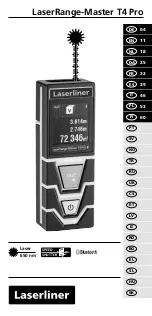
8-7
IM 253710-01E
Numerical Display
8
Resetting the order of the displayed items
If the number of displayed items is set to something other than [ALL], the order of the
displayed items can be reset to a preset order. For details regarding the reset
information, see Appendix 4, “List of Initial Settings and Display Order of Numerical
Data.”
Scrolling the display
Because all the data cannot fit on one screen, a scroll function is provided.
• When the number of displayed items is set to something other than [All]
Turn the jog shuttle to move the highlight to another measurement function. The
menu items that are displayed change as follows.
• Norm Item No.
The data number of the highlighted measurement function is displayed.
• Function
The symbol representing the highlighted measurement function is displayed.
When [None] is displayed, an item without a selected measurement function is
being specified using the jog shuttle. In this case, the area for displaying the
measurement function and data displays [-------] (no data).
• Element
The element/wiring method of the highlighted measurement function is
displayed.
• When the number of displayed items is set to [All]
Turn the jog shuttle to move the highlight to another measurement function. The
symbol representing the highlighted measurement function is displayed in the
[Function] section of the menu. [-------] (no data) is displayed in places where there
are no numerical data.
Note
•
For the meanings of the measurement function symbols, see section 1.2, “Measurement
Modes and Measurement/Computation Periods,” 1.7 “Numerical Computation,” appendix 2
“Symbols and Determination of Measurement Functions,” and appendix 3 “Determination of
Delta Functions.”
•
For details regarding the wiring methods, A and B, see section 5.2, “Selecting the Wiring
Method.”
•
[-------] (no data) is displayed in places where the measurement function is not selected or
there are no numerical data.
•
If the measurement/computation results cannot be displayed using the specified decimal point
position or unit, [-OF-] (overflow) is displayed.
•
When the voltage or current input is less than or equal to 0.25% of the measurement range,
Urms, Umn, Uac, Irms, Imn, Iac, and all other measurement functions that are determined
using these measurement functions will display zeroes.
λ
or
φ
will display an error [Error].
•
When the frequency of the measured value is outside the measurement range or when the
input signal is less than or equal to approximately 3.5% of the measurement range, fU or fI
will display an error [Error].
•
When both the voltage and current are sinusoids and the ratio of the voltage and current
inputs do not differ greatly with respect to the measurement range, the phase difference
φ
of
lead (D) and lag (G) are detected and displayed correctly.
•
When the power factor
λ
is greater than 1.001 and less than equal to 2.000,
λ
becomes [1].
φ
displays zero.
•
When the power factor
λ
is greater than 2.001,
λ
and
φ
display errors [Error].
•
fU and fl are measured using zero cross detection. An error results if 2 or more zero cross
points are not detected on the rising slope of the input signal during the observation time.
8.2 Displaying Normal Measurement Data
















































